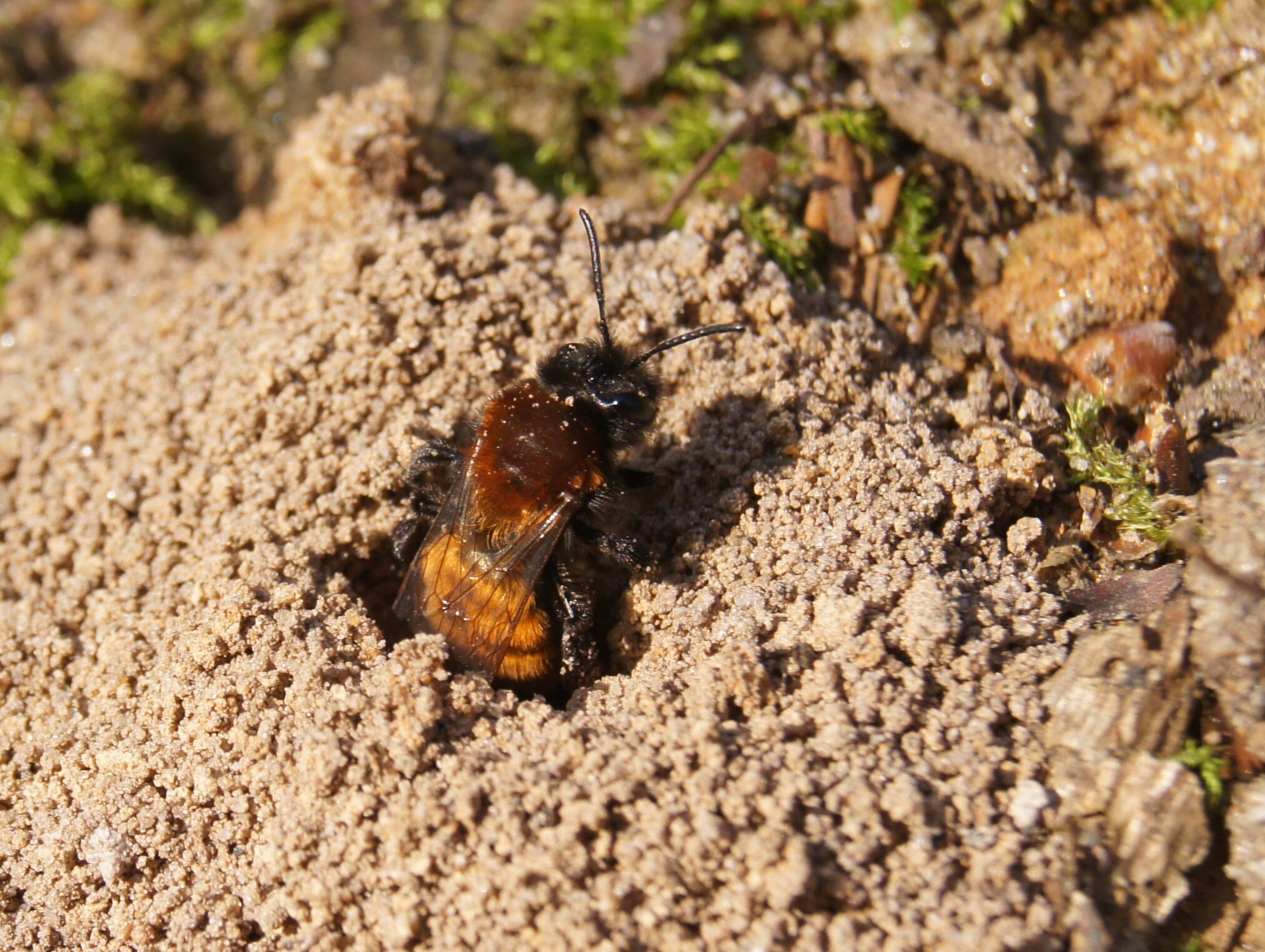The life and times of mining bees
As spring sunshine warms the soil and wildflowers bloom, insects are also awakening. As you walk around Hampstead Heath, you may notice gatherings of them zigzagging low over open, sunlit ground, the earth itself pockmarked with holes or little ‘soil volcanoes’. These are likely to be Mining Bees.
Tawny mining bee © Rory Dimond
Mining bees Andrena spp. are ground-nesting solitary bees which excavate nest tunnels in the soil*. The ‘solitary’ part refers to their nesting habits rather than their social lives! You may see them in aggregations numbering the hundreds around nesting sites, but each female cares for her own nest burrow. In fact, although the word ‘bee’ tends to conjure images of social honeybees or bumblebees, most bee species are solitary. In the UK we have just 1 honeybee and 26 bumblebees, but over 220 solitary bees! Around 70 of these are mining bees.
However, solitary bees are often overlooked, since they tend to be small, dowdy and less fuzzy than their relatives, so are easily mistaken for flies or wasps. This is a shame, since they are amongst our most fascinating and important pollinators.
Fortunately, some of the commonest spring mining bees are easily identified and you can often see them on Hamsptead Heath. Two of the most engaging are the gloriously ginger Tawny mining bee Andrena fulva with a fuzzy orange coat and thick black hairs on its face and legs, alongside the Ashy mining bee Andrena cineraria, the panda of the bee world with a banded black and white fluffy thorax and a glossy blue-black abdomen
Ashy mining bee © Rory Dimond
Most mining bees emerge in spring. After waiting out the winter as dormant adults in their natal nest burrows, they emerge with the increasing warmth. The skinny, bobble-headed males are out first, and patrol manically in search of females - zigzagging around nest sites, flowers and sunlit bushes. The male’s sole role in life is to mate, an inelegant affair usually beginning with grabbing a female in mid-air and tumbling to the ground!
The life of a female mining bee is tough, as she is in essence a single mum. After mating and fuelling up on nectar, she has to find a place to nest and excavate her burrow. This is usually in sunny, bare, or sparsely vegetated ground, such as a bank or the edge of a footpath. She digs using her strong jaws to break up the soil and sweeping the spoil away with her legs. Eventually she makes a tunnel branching into several nest chambers. She stocks each of these with pollen as a food store for her growing brood, before laying a single egg inside and sealing it up. It will take her many trips to complete each cell in turn.
Willows Salix spp., Dandelions Taraxacum spp. and Lesser Celandines Ficaria verna are excellent spring pollen sources. Staking out a sunny patch of these flowers is a great way to look for mining bees. Watch closely when females arrive and you’ll see them brushing loose pollen onto their hairy rear legs. It’s this pollen-collecting method that makes solitary bees much more efficient pollinators than bumblebees or honeybees. The Social bees stick the pollen down onto their legs with nectar or saliva, which means less is dusted off onto the flowers to pollinate them. We should be thankful to solitary bees too, since studies show they are the most efficient pollinators of our orchard fruits.
A pollen-laden Clarke’s mining bee Andrena clarkella returns to provision her nest © Liz Andrew
A Dark-edged Bee-fly Bombylius major © Jo Maddox
Back at the nest, the female’s food provisions do not go unnoticed. She lines the burrow with ant-repellent compounds to keep those tiny foragers at bay, but other insects nip in to take advantage of her hard work. Some of these are other bees, termed ‘cuckoo bees’. Like their namesake bird, they specialise in laying their eggs in the nests of others.
Bee-flies Bombylius spp. can also be spotted around the nest sites. These fuzzy bumblebee mimics hover over the holes and flick their eggs into the nest entrance where their larvae will grow up, feeding first on the pollen stores and then the fattened bee larva. Although these nest parasites sound sinister, they don’t have a significant impact on mining bee populations. The bees have uneasily coexisted with them for millennia, and many more mining bees will emerge the following spring.
A mining bee nest site is a hive of activity, and well worth a watch on a sunny spring day. To top it off, mining bees do not sting, so are perfectly safe to watch closely. You might even have nests in your lawn or between patio slabs. Look out for these industrious pollinators in spring.
Do you want to find out more? Check out our guided nature walks on Hampstead Heath, read our blog post on wildflower meadows on the heath, find out about all the different natural habitats on our green spaces. You can also click on ‘wildlife’ below to find other articles about the Heath’s wildlife species.
You can also support mining bees (and other species!) by donating to our project to create wildflower meadows on Hampstead Heath here.
*If you have a bee hotel in your garden, these cater for ‘aerial-nesting’ solitary bees, such as Mason bees Osmia spp. and Leafcutter bees Megachile spp. . One species to watch out for in London in early spring is the European orchard bee Osmia cornuta, a recent arrival to the UK.




